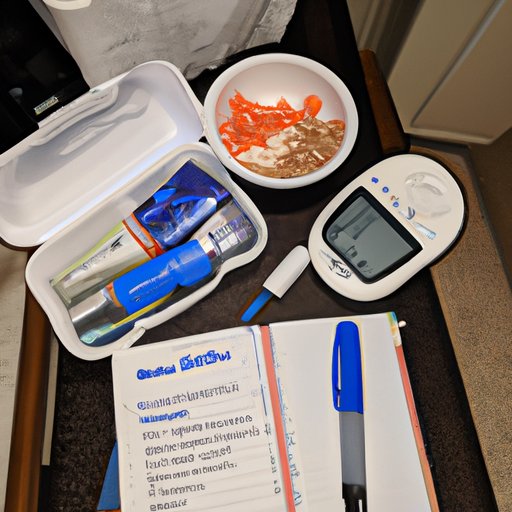Introduction
Diabetes is an increasingly common chronic health condition that affects millions of people around the world. It’s caused by the body’s inability to either produce or use insulin properly, leading to elevated blood sugar levels. Managing diabetes requires a combination of lifestyle changes, including a balanced diet. This article will provide an overview of the diabetic diet and explore the basics of a diabetic diet, tips for success, and recipes suitable for a diabetic diet.

Explaining the Basics of a Diabetic Diet
A diabetic diet is an eating plan designed to help control blood sugar levels and reduce the risk of complications associated with diabetes. While there is no one-size-fits-all approach, there are some general guidelines to follow when creating a diabetic diet.
Macronutrient Considerations
When it comes to macronutrients, the focus should be on quality over quantity. Choose nutrient-dense sources of carbohydrates such as whole grains, fruits, vegetables, legumes, and dairy products. Limit your intake of refined carbohydrates such as white bread, pasta, and sugary snacks. For protein, choose lean sources such as fish, poultry, beans, and nuts. Healthy fats should come from sources such as olive oil, avocados, and nuts.
Glycemic Index
The glycemic index (GI) is a tool used to measure how quickly a food raises blood sugar levels. Foods with a high GI (70 or more) are broken down quickly and cause a rapid spike in blood sugar. Foods with a low GI (55 or less) are broken down slowly and cause a gradual rise in blood sugar. When creating a diabetic diet, focus on consuming foods with a low GI to help keep blood sugar levels stable.
Meal Planning
Meal planning is an important part of managing diabetes. Aim to include a variety of foods from each food group to ensure you’re getting all the nutrients you need. It’s also important to spread out carbohydrate intake throughout the day and opt for smaller meals and snacks if needed.
Tips for Success
There are a few things you can do to make following a diabetic diet easier. Start by stocking your kitchen with healthy staples like whole grains, fresh fruits and vegetables, lean proteins, and healthy fats. Meal prep ahead of time so you always have healthy meals and snacks on hand. And don’t forget to get creative in the kitchen—try new recipes and experiment with flavors!

A Day in the Life of a Diabetic Dieter
Eating a healthy, balanced diet is key to managing diabetes. Here’s a sample of what a day of eating on a diabetic diet might look like:
Sample Breakfast
Start the day off right with a nutritious breakfast. Try oatmeal topped with fresh berries and chopped walnuts, or a spinach and mushroom omelet with a side of fruit.
Sample Lunch
For lunch, try a quinoa salad loaded with veggies and topped with grilled chicken or salmon. Or, opt for a turkey wrap with hummus, lettuce, and tomatoes.
Sample Dinner
End the day with a nourishing dinner. Try roasted salmon with a side of roasted vegetables, or a veggie stir-fry with brown rice.
Interviewing a Registered Dietitian on the Benefits of a Diabetic Diet
We spoke with registered dietitian Sarah Smith about the benefits of a diabetic diet and how to make it easier to stick to. Here’s what she had to say:
Benefits of a Diabetic Diet
According to Smith, “Following a healthy diabetic diet can help keep blood sugar levels stable, reduce the risk of complications associated with diabetes, and improve overall health. Eating a balanced diet full of nutrient-dense foods can also help with weight management, which can be beneficial for those with diabetes.”
Guidelines for Eating Out
Eating out can be tricky when you’re trying to manage diabetes. Smith recommends asking questions about ingredients and portion sizes, opting for grilled or baked dishes over fried, and skipping the sugary drinks. “It’s also important to remember that it’s OK to indulge every once in awhile—just be mindful of portion sizes and opt for healthier options when possible,” she says.
Strategies for Overcoming Challenges
Smith offers these tips for staying on track with a diabetic diet: “Don’t be afraid to ask for help if you need it. Working with a registered dietitian can be very beneficial in helping you create a meal plan that works for you. Additionally, don’t be too hard on yourself if you slip up—just focus on getting back on track and don’t give up.”

Comparing Different Types of Diabetic Diets
When it comes to diabetic diets, there are a few different approaches to consider. Here’s a look at three popular types of diabetic diets:
Low Carb vs. Low Fat
Low carb diets involve limiting your intake of carbohydrates and replacing them with protein and healthy fats. Low fat diets, on the other hand, focus on reducing fat intake and increasing consumption of whole grains, fruits, and vegetables. Both approaches can be effective for managing diabetes, but it’s important to talk to your doctor before making any drastic changes to your diet.
Mediterranean vs. Vegan
The Mediterranean diet focuses on consuming mostly plant-based foods, such as fruits, vegetables, legumes, and whole grains. It also includes healthy fats such as olive oil and fish. A vegan diet eliminates all animal products, including meat, dairy, and eggs. Both of these diets can be beneficial for managing diabetes, but it’s important to ensure you’re getting enough essential vitamins and minerals.
Intermittent Fasting
Intermittent fasting involves alternating periods of fasting and eating. Studies have shown that this type of diet can be effective for managing diabetes, but it’s important to talk to your doctor before starting any new diet.
Exploring Recipes Suitable for a Diabetic Diet
Eating a healthy, balanced diet is key to managing diabetes. Here are some delicious recipes you can add to your meal plan:
Breakfast Ideas
Try an egg and vegetable scramble with whole grain toast, or Greek yogurt parfait with fresh berries and almonds.
Lunch Ideas
Opt for a quinoa and black bean burrito bowl, or a chickpea salad sandwich with a side of fruit.
Dinner Ideas
Try roasted salmon with roasted vegetables, or a vegetable stir-fry with brown rice.
Conclusion
Managing diabetes requires a combination of lifestyle changes, including a balanced diet. This article provided an overview of the diabetic diet and explored the basics of a diabetic diet, tips for success, and recipes suitable for a diabetic diet. Additionally, we compared different types of diabetic diets and discussed the benefits of a diabetic diet with a registered dietitian.
If you’re looking to start living a healthier life and managing your diabetes, consulting with a registered dietitian can be beneficial. They can help you create a meal plan that works best for you and provide support and guidance along the way. Additionally, there are many resources available online to help you get started.
By following a healthy diabetic diet, you can better manage your blood sugar levels and reduce the risk of complications associated with diabetes. With the right information and support, you can make lasting changes to your lifestyle and enjoy the benefits of a healthier life.
(Note: Is this article not meeting your expectations? Do you have knowledge or insights to share? Unlock new opportunities and expand your reach by joining our authors team. Click Registration to join us and share your expertise with our readers.)
